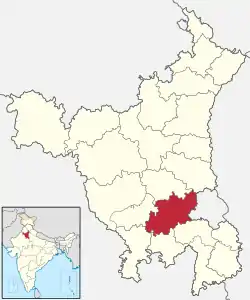Jhajjar district
Jhajjar district is one of the 22 districts of Haryana state in northern India. Carved out of Rohtak district on 15 July 1997 and with its headquarters in Jhajjar, it lies 29 kilometres (18 mi) from Delhi and had developed into an important industrial center. Other towns in the district are Bahadurgarh and Badli and Beri. Bahadurgarh is the major city of the district & state. Bahadurgarh is known as 'The City of Destiny'. Beri used to be a village fifty years ago.
Jhajjar district | |
|---|---|
District of Haryana | |
 Location of Jhajjar district in Haryana | |
| Country | |
| State | Haryana |
| Headquarters | Jhajjar |
| Tehsils | Jhajjar Bahadurgarh Badli Beri Matanhail |
| Area | |
| • Total | 1,834 km2 (708 sq mi) |
| Population (2011) | |
| • Total | 958,405 |
| • Density | 520/km2 (1,400/sq mi) |
| • Urban | 22.17% |
| Time zone | UTC+05:30 (IST) |
| Vehicle registration | HR 14 |
| Major highways | NH9 and NH71 |
| Lok Sabha constituencies | Rohtak (shared with Rohtak and Rewari districts) |
| Vidhan Sabha constituencies | 4 |
| Website | http://jhajjar.nic.in/ |
The district occupies an area of 1,834 square kilometres (708 sq mi) and as of 2001 its population was 709,000. It has two industrial areas with over 3300 industries. Basic industries are ceramics, glass, chemicals, engineering, electrical and electronics. Bahadurgarh is the major Industrial area of the district with over 2800 medium size industries and 200 large-scale industries. There are 3300 units representing a total investment of Rs. 40000 million. Major crops grown here are rice, wheat and maize. The total irrigated agricultural land area is about 670 square kilometres (260 sq mi).
Jhajjar is said to have been founded by Chhaju Jaat as Chhajunagar, which was later changed to Jhajjar. Alternatively, it may be derived from Jharnaghar, meaning a natural fountain or Jhajjar, a water vessel, because the surface drainage of the country for miles around runs into the town as into a sink. Bahadurgarh, founded by Rathee Jats, was formerly known as Sharafabad.
Demographics
| Year | Pop. | ±% p.a. |
|---|---|---|
| 1901 | 220,225 | — |
| 1911 | 189,979 | −1.47% |
| 1921 | 204,808 | +0.75% |
| 1931 | 213,977 | +0.44% |
| 1941 | 253,298 | +1.70% |
| 1951 | 295,085 | +1.54% |
| 1961 | 375,209 | +2.43% |
| 1971 | 479,482 | +2.48% |
| 1981 | 589,212 | +2.08% |
| 1991 | 715,136 | +1.96% |
| 2001 | 880,072 | +2.10% |
| 2011 | 958,405 | +0.86% |
| source:[1] | ||
As of the 2011 census Jhajjar district had a population of 958,405,[2] roughly equal to the nation of Fiji[3] or the US state of Montana.[4] This gives it a ranking of 456th in India (out of a total of 640).[2] The district has a population density of 522 inhabitants per square kilometre (1,350/sq mi).[2] Its population growth rate over the decade 2001-2011 was 8.73%.[2] Jhajjar has a sex ratio of 782 females for every 1000 males,[2] and a literacy rate of 80.8%.[2]
At the time of the 2011 Census of India, 98.94% of the population in the district spoke Hindi and 0.40% Punjabi as their first language.[5]
Jat is the dominant caste in the district. According to census 2011 Jhajjar city has a population of 48424, Beri has 15934, and the major city of the district Bahadurgarh has 170,767.
In the 2011 National Census, it was found that Jhajjar district has the lowest sex ratio in India of the 0-6 group, with just 782 girls to 1,000 boys.[6] Two villages in Jhajjar have extremely low gender-ratios: Bahrana and Dimana have gender ratios of 378 girls to 1,000 boys and 444 girls to 1,000 boys respectively.[7] In Jhajjar, parents are able to illegally learn the gender of the fetus through secret early morning ultrasounds at registered clinics and through the use of code-words, Ladoo for boy and Jalebi for girl; these families often go on to abort female fetuses.[6]
Divisions
Jhajjar district is divided into 4 sub-divisions: Jhajjar, Bahadurgarh, Badli and Beri. Jhajjar sub-division comprises two tehsils: Jhajjar and Matanhail. Bahadurgarh sub-division comprises only one tehsil, Bahadurgarh. Badli and Beri sub-division also comprises only one tehsil each.
There are four Haryana Vidhan Sabha constituencies in this district: Bahadurgarh, Badli, Jhajjar and Beri. All of these are part of Rohtak Lok Sabha constituency.
Industries
Bahadurgarh -'The City of Destiny' is the major industrial estate of the district. Bahadurgarh alone covers 3,000 industries out of 3,300 total industries in district. Basic industries are ceramics, glass, chemicals, engineering, electrical and electronics.
SSI & MSI units
In Jhajjar District. there are 1818 SSI (Small Scale Industries) units registered as of 31 December 2000. The total approximate investment of these units is 9550.01 lakhs and total employment in these units is 12153. In 2016, there are 3050 SSI or MSI in Jhajjar district, out of which Bahadurgarh alone have 2800 MSI (Medium Size Industries).
LSI units
There are over 250 LSI in the District in 2016 which are engaged in the manufacturing. Out of these 250 LSI (Large Scale Industries), 200 are in Bahadurgarh.
See also
References
- Decadal Variation In Population Since 1901
- "District Census 2011". Census2011.co.in. 2011. Retrieved 30 September 2011.
- US Directorate of Intelligence. "Country Comparison:Population". Retrieved 1 October 2011.
Fiji 883,125 July 2011 est.
- "2010 Resident Population Data". U. S. Census Bureau. Archived from the original on 19 October 2013. Retrieved 30 September 2011.
Montana 989,415
- 2011 Census of India, Population By Mother Tongue
- "Ladoo and Jalebis: The code of killer doctors of jatland". The Times Of India. 8 April 2011.
- "Jhajjar village has 378 girls for 1,000 boys". The Times Of India. 8 April 2011.
- http://www.census2011.co.in/census/district/222-jhajjar.html